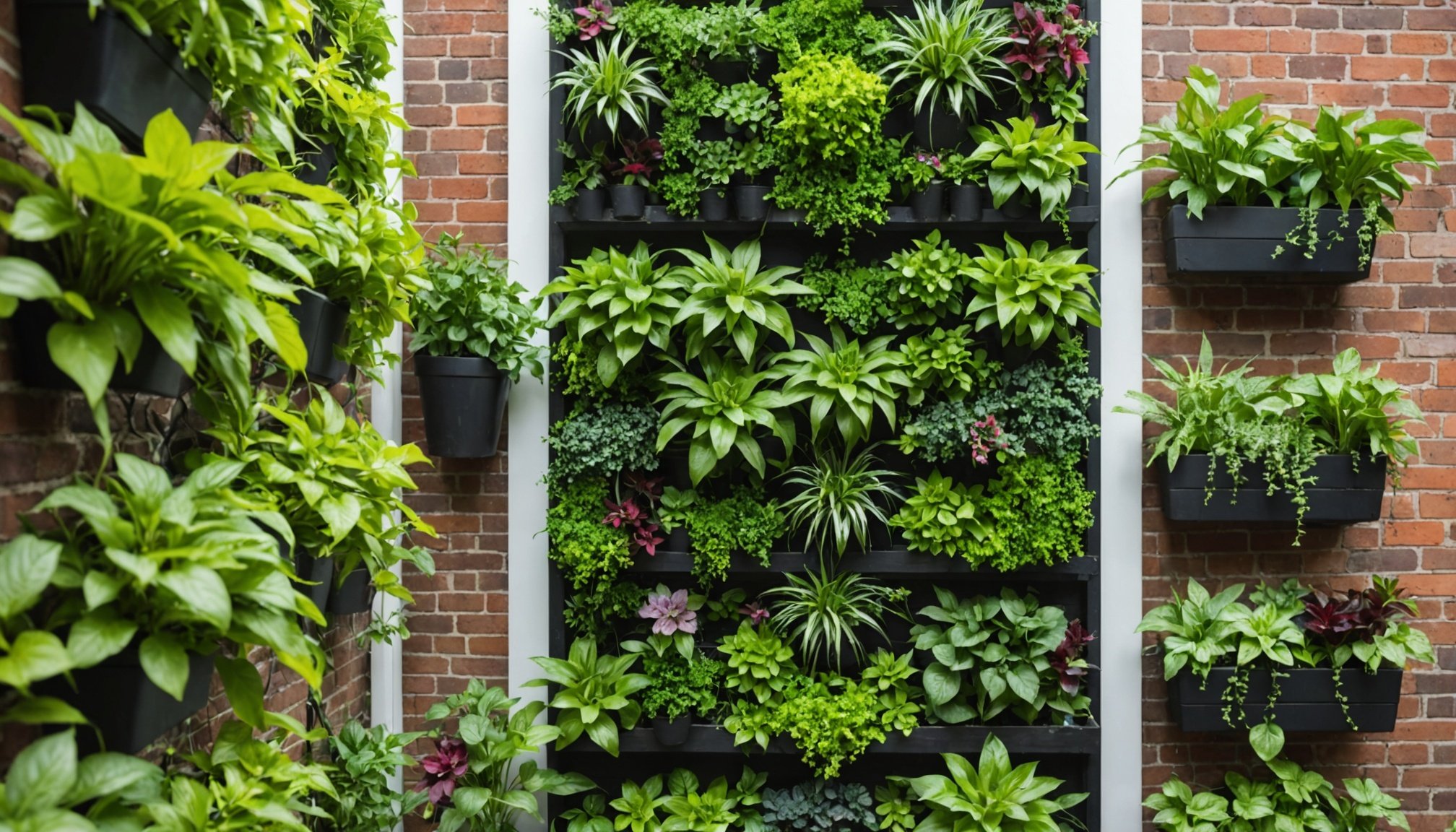Limited outdoor space shouldn't hinder your passion for gardening. Discover how a vertical garden can transform your UK flat into a vibrant green oasis. Not only does this innovative approach save space, but it also enhances air quality and beautifies your living area. With practical tips and tailored plant selections, you can create a lush vertical garden that thrives in your unique environment. Say goodbye to garden envy and hello to your own green sanctuary!
Understanding Vertical Gardening
Vertical gardening offers a revolutionary approach to cultivating plants, especially in urban settings where space is often limited. This method involves growing plants on vertically inclined surfaces, such as walls or specially designed structures. It's an ideal solution for those interested in gardening but constrained by small spaces. By utilizing vertical gardening basics, individuals can transform even the tiniest balconies or patios into lush, green havens.
A voir aussi : Ultimate Guide for UK Homeowners: Selecting the Best Roof Insulation for Minimal Disruption and Maximum Efficiency
Benefits of Vertical Gardens
Vertical gardens provide numerous benefits, particularly in urban environments. They help maximize limited outdoor space by allowing plants to grow upwards rather than outwards. This is especially advantageous for city dwellers who often lack the expansive gardens found in rural areas. Moreover, vertical gardens can improve air quality, reduce noise pollution, and even lower temperatures by providing additional shade.
Gardening in Small Spaces
For those with limited outdoor areas, vertical gardening is a game-changer. It enables the cultivation of a wide variety of plants, from herbs and vegetables to ornamental flowers, without requiring large plots of land. This approach not only optimizes space but also enhances the aesthetic appeal of urban living spaces, making them more vibrant and inviting.
Avez-vous vu cela : Top Pet-Friendly Flooring Solutions for UK Homes with Indoor Pets: A Comprehensive Guide
Planning Your Vertical Garden
Before embarking on your vertical gardening journey, it is crucial to focus on planning. Begin by assessing the available space in your flat. Consider areas such as balconies, walls, or even unused corners that could host a garden. This assessment will guide you in choosing an appropriate location for your vertical garden.
Space Assessment
Evaluate the dimensions and lighting conditions of potential spots. Ensure the chosen area receives adequate sunlight, as this is vital for plant growth. If natural light is limited, consider installing artificial lighting to support your plants' needs.
Choosing an Appropriate Location
Select a location that complements your living space while providing the necessary conditions for your plants. Balconies or sunny walls are ideal for a vertical garden. Ensure the spot is accessible for maintenance and watering.
Design Considerations
When planning your vertical garden, think about design ideas that enhance both aesthetics and functionality. Incorporate a mix of plants with varying textures and colours to create visual interest. Use modular systems or DIY structures that suit your style and space. Prioritise easy access to each plant for care and harvesting, ensuring your garden remains both beautiful and practical.
Selecting the Right Plants
Choosing the right plants is crucial for a successful vertical garden, especially in the UK climate. Consider plant varieties that thrive in limited space and can adapt to vertical growth. Opt for species such as ferns, ivy, and succulents, which are well-suited for vertical gardens due to their adaptability and minimal maintenance requirements.
Ideal Plant Varieties for Vertical Gardens in the UK
In the UK, it's essential to select plants that can withstand varying weather conditions. Hardy perennials, like lavender and heuchera, are excellent choices as they can survive colder temperatures. For edible options, consider herbs like thyme and mint, which flourish in vertical settings and offer culinary benefits.
Factors to Consider When Choosing Plants
When selecting plants, consider their compatibility with your garden's microclimate. Ensure that the plants you choose have similar light and water requirements to simplify maintenance. Additionally, consider the growth habits of each plant to prevent overcrowding and ensure healthy development.
Companion Planting Techniques
Enhance your vertical garden by using companion planting techniques. Pairing plants that benefit each other can improve growth and deter pests. For instance, planting basil alongside tomatoes can enhance flavour and repel insects, creating a harmonious and productive garden environment.
Vertical Garden Structures and Materials
Vertical gardens can be constructed using a variety of structures and materials, each offering unique benefits. Popular options include planters, trellises, and wall-mounted systems. Planters are versatile and can be arranged in numerous configurations, making them ideal for both small and large spaces. Trellises support climbing plants, adding height and visual interest to your garden. Wall-mounted systems, meanwhile, are perfect for maximizing space in tight areas.
When selecting materials for vertical gardens, consider durability and weight. Lightweight materials like plastic or metal are often recommended due to their ease of installation and maintenance. Wood is another popular choice, offering a natural aesthetic but requiring treatment to withstand weather conditions.
For those interested in DIY options, there are several budget-friendly solutions. Repurposing materials such as old pallets or plastic bottles can create effective and sustainable vertical garden structures. Additionally, using simple tools and materials available at home improvement stores can help keep costs low while allowing for customization. By exploring these options, you can create a vertical garden that suits your style and space without breaking the bank.
Step-by-Step Installation Guide
Installing a vertical garden requires careful planning and execution to ensure successful plant growth. Begin by preparing the wall or structure where your garden will be mounted. Ensure the surface is sturdy and can support the weight of the plants and soil. If necessary, reinforce the wall with additional support or choose a freestanding structure designed for vertical gardening.
Planting Techniques for Vertical Arrangements
When setting up your vertical garden, consider the step-by-step gardening process for planting techniques. Start by arranging plants in a way that maximises their exposure to sunlight and air circulation. Place larger plants at the bottom and smaller ones at the top to prevent overshadowing. This arrangement promotes optimal growth and ensures each plant receives adequate light.
Tips for Arranging Plants for Optimal Growth
- Group plants with similar water and light requirements together to simplify maintenance.
- Use a mix of trailing and upright plants to create visual interest and fill spaces effectively.
- Regularly check for pests and remove dead leaves to maintain plant health.
By following these steps, you can create a thriving vertical garden that enhances your living space and supports healthy plant development.
Watering and Irrigation Techniques
Efficient watering is crucial for maintaining healthy vertical gardens. Watering vertical gardens requires specific techniques due to their unique structure. Gravity plays a significant role, so it's essential to ensure even water distribution.
Best Practices for Watering Vertical Gardens
- Assess moisture levels regularly to avoid overwatering.
- Water in the early morning or late afternoon to reduce evaporation.
- Use a watering can with a long spout or a hose with a gentle spray nozzle for targeted watering.
Exploring Drip Irrigation Systems for Efficiency
Drip irrigation systems are ideal for vertical gardens, providing consistent moisture while conserving water. These systems deliver water directly to the plant roots, minimising waste and ensuring each plant receives adequate hydration. Installing a timer can further enhance efficiency by automating watering schedules.
Preventing Overwatering and Ensuring Plant Health
Overwatering can lead to root rot and other health issues. To prevent this, ensure proper drainage by using well-aerated soil and containers with drainage holes. Regularly check for signs of overwatering, such as yellowing leaves or soggy soil, and adjust watering routines accordingly. By following these tips, you can maintain a thriving and healthy vertical garden.
Maintenance and Care
Proper vertical garden maintenance is essential for keeping your green space lush and thriving. Regularly inspect your plants for signs of stress or disease, and remove any dead or damaged foliage to promote healthy growth. Plant care involves monitoring soil moisture and adjusting watering schedules as needed. Ensure that each plant receives adequate nutrients by applying a balanced fertiliser periodically.
Routine Maintenance Tasks
- Pruning: Regularly trim plants to encourage bushier growth and prevent overcrowding.
- Cleaning: Remove debris and fallen leaves to reduce the risk of pests and diseases.
- Inspection: Check for pests and signs of disease, and address issues promptly.
Seasonal Considerations
Adapt your care routine to suit the changing seasons. In winter, protect sensitive plants from frost by using covers or relocating them indoors. During summer, increase watering frequency to combat heat stress. Adjust fertilisation schedules based on plant growth cycles and seasonal needs.
Pest Management Strategies
Implement effective pest management strategies to safeguard your vertical garden. Use natural predators, such as ladybirds, to control aphid populations. Consider organic solutions like neem oil to deter pests without harming beneficial insects. Regularly inspect plants for infestations and take action promptly to maintain a healthy garden environment.
Enhancing Your Vertical Garden Aesthetics
Elevate the visual appeal of your vertical garden with creative design ideas. Start by exploring aesthetic tips for vertical gardens, which can transform your space into a captivating oasis. Consider integrating various plant textures and colours to create a dynamic visual experience.
Creative Ways to Enhance Visual Appeal
Incorporate decor ideas such as decorative pots or colourful planters to add personality to your garden. Opt for a mix of trailing and upright plants to create depth and intrigue. These elements will not only enhance your garden's beauty but also make it a focal point of your outdoor area.
Using Accessories and Decor
Accessories can play a significant role in garden design. Use items like garden sculptures or wind chimes to add charm and character. Additionally, consider integrating vertical garden trellises or frames that complement your plant arrangements, providing both support and style.
Incorporating Lighting for Evening Displays
To ensure your vertical garden shines even after sunset, incorporate strategic lighting. Use solar-powered string lights or LED spotlights to highlight key features, creating a stunning evening display. This not only extends the usability of your garden but also enhances its overall aesthetics.
Resources and Further Reading
Embarking on a vertical gardening journey requires the right resources and knowledge. To deepen your understanding, consider delving into gardening guides and books specifically focused on vertical gardening. Titles like "Vertical Gardening: Grow Up, Not Out, for More Vegetables and Flowers in Much Less Space" provide comprehensive insights into techniques and plant selection.
When it comes to product recommendations, investing in quality tools and materials is crucial. Look for sturdy trellises, modular planters, and efficient irrigation systems to ensure your garden thrives. Brands like Gardena and Fiskars offer reliable tools that can assist with maintenance and installation.
Engaging with gardening communities can offer additional support and inspiration. Online forums such as GardenWeb and Reddit's r/gardening are excellent platforms to exchange ideas, seek advice, and share experiences with fellow vertical gardeners. These communities provide a wealth of shared knowledge and can help troubleshoot any challenges you may encounter.
By leveraging these resources, you can enhance your vertical gardening skills and create a flourishing green space. Whether through literature, product investments, or community engagement, these tools will support your gardening endeavours.












